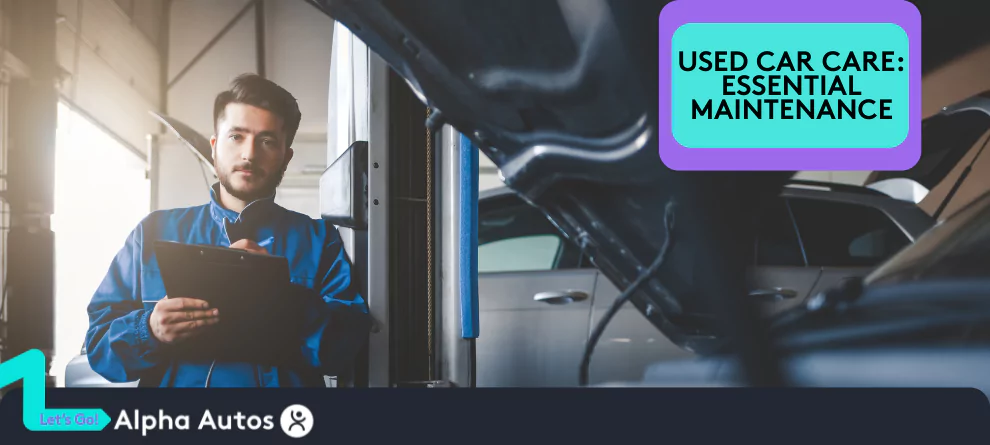

Used Car Care: Essential Maintenance for Longevity & Reliability
Congratulations on becoming a used car owner! You’ve made a practical choice, and now, ensuring your vehicle’s reliability, safety, and longevity becomes paramount, particularly for a pre-owned car facing diverse Australian conditions – from scorching summers to dusty outback roads. Proactive maintenance isn’t just about fixing problems; it’s about preventing them, saving you money and stress down the line.
This comprehensive guide aims to empower every used car owner in Australia by outlining the essential maintenance tasks they should prioritise to keep their vehicle running smoothly and safely for years to come. And if you’re still in the market, be sure to explore the wide range of quality used cars for sale across Australia to find the perfect match for your needs and budget.
The First Things First: Initial Checks and Services
-
Full Service by a Trusted Mechanic:
- Comprehensive Inspection: This initial service should involve a thorough inspection of all major systems, including the engine, transmission, brakes, suspension, steering, cooling system, and electrical components.
- Diagnostic Scan: A mechanic will likely perform a diagnostic scan to check for any stored error codes in the car’s computer system, which can indicate underlying issues not immediately apparent.
- Fluid Checks: Beyond just levels, the mechanic will assess the condition of the fluids, looking for signs of contamination or degradation.
- Component Checks: They’ll inspect belts, hoses, filters, and other wear-and-tear items for damage or imminent failure.
- Peace of Mind: This service provides a valuable baseline understanding of your used car’s condition and allows you to address any urgent repairs or maintenance needs right away, offering peace of mind.
-
Oil and Filter Change:
- Quality Matters: Ensure your mechanic uses a high-quality engine oil with the correct viscosity grade for your vehicle and the Australian climate (consider synthetic oils for better protection in extreme temperatures).
- Genuine or Reputable Filters: Opt for a genuine or reputable aftermarket oil filter to ensure proper filtration and protect your engine from contaminants.
- Record Keeping: Keep a record of the date, mileage, and type of oil used for future reference.
-
Fluid Levels Check and Top-Up/Flush:
- Coolant: Check the coolant level and the concentration of the antifreeze/coolant mixture, ensuring it’s adequate for both hot and potentially cooler Australian temperatures. Look for any leaks or signs of rust in the cooling system. A flush and refill might be necessary if the coolant is old or contaminated.
- Brake Fluid: Brake fluid is hygroscopic, meaning it absorbs moisture over time, which can lead to corrosion and reduced braking performance. If the fluid looks dark or the service history is unknown, a complete brake fluid flush is a critical safety measure.
- Power Steering Fluid: Check the level and condition of the power steering fluid. Low levels can indicate leaks, and old fluid can cause steering issues.
- Transmission Fluid: For both automatic and manual transmissions, check the fluid level and condition. Automatic transmission fluid (ATF) that is dark or has a burnt smell indicates it needs changing. Manual transmission fluid should also be inspected and changed according to the service manual.
- Windscreen Washer Fluid: Ensure the reservoir is full with a quality windscreen washer fluid, especially important for keeping your windscreen clear of dust and grime in Australian conditions.
Regular Engine Maintenance: The Heart of Your Ride
-
Regular Oil and Filter Changes:
- Manufacturer’s Recommendations: Consult your owner’s manual for the specific oil change intervals recommended by the manufacturer.
- Severe Driving Conditions: If you frequently drive in stop-start traffic, extreme heat, or dusty environments – common in Australia – consider shortening the oil change intervals.
- Oil Condition Monitoring: Pay attention to the colour and consistency of your engine oil. Dark, sludgy oil indicates it’s time for a change, regardless of mileage.
-
Air Filter Replacement:
- Visual Inspection: Regularly inspect your air filter. If it looks dirty or clogged, replace it. Don’t just rely on the service schedule, especially if you drive in dusty areas.
- Benefits of a Clean Filter: A clean air filter improves airflow to the engine, leading to better combustion, increased power, and improved fuel economy.
-
Spark Plugs and Ignition System:
- Scheduled Replacement: Replace spark plugs according to the manufacturer’s recommended intervals to maintain optimal engine performance and fuel efficiency.
- Inspection of Components: During spark plug replacement, have your mechanic inspect the ignition leads (spark plug wires) for cracks, brittleness, or damage. Also, check the ignition coils for any signs of failure. Faulty ignition components can cause misfires, rough idling, and reduced power.
-
Timing Belt/Chain Inspection:
- Critical Replacement Interval: The timing belt has a specific replacement interval (usually based on mileage or time). Ignoring this can lead to the belt snapping, causing the pistons and valves to collide, resulting in severe and costly engine damage.
- Visual Checks (Belt): If your engine has a timing belt (as opposed to a chain), ask your mechanic to visually inspect it for cracks, fraying, or wear during routine services.
- Timing Chain Considerations: Timing chains generally last longer than belts, but they can still stretch or fail over time. Listen for any unusual rattling noises from the engine, which could indicate an issue with the timing chain or its tensioners.
Keeping it Cool: Cooling System Care in the Australian Heat
-
Coolant Flush and Replacement:
- Why it’s crucial in Australia: The intense heat experienced across much of Australia puts significant stress on your engine’s cooling system. Old coolant loses its ability to effectively transfer heat, leading to overheating, which can cause severe engine damage like warped cylinder heads or blown gaskets.
- Signs of old coolant: Discoloured (rusty brown or murky), contains sediment, or has been in the system for longer than the manufacturer’s recommendation (typically every 2-5 years or a specific mileage).
- Correct coolant type: Ensure the correct type of coolant (ethylene glycol or organic acid technology – OAT) is used as specified in your owner’s manual. Mixing different types can lead to corrosion and reduced efficiency.
- Professional service recommended: A proper flush ensures all old coolant and contaminants are removed before new coolant is added.
-
Radiator and Hoses Inspection:
- Radiator: Look for external corrosion (especially around hose connections), leaks (often indicated by dried coolant stains), and bent or damaged cooling fins (which reduce cooling efficiency).
- Hoses: Check for swelling (a sign of internal degradation), cracks (even small ones can lead to leaks under pressure), leaks (look for wet spots or dried residue), and softness or sponginess (indicating the rubber is breaking down). Pay attention to hose clamps for tightness and corrosion.
- Early detection saves money: Replacing a hose before it bursts can prevent a costly breakdown and potential engine damage.
-
Thermostat Check:
- Function: The thermostat regulates the flow of coolant to maintain the engine’s optimal operating temperature.
- Symptoms of a faulty thermostat:
- Stuck closed: Engine overheats quickly, temperature gauge reads high.
- Stuck open: Engine takes a long time to warm up, temperature gauge reads low (can affect fuel efficiency and heater performance).
- Testing: A mechanic can test the thermostat’s operation by observing how the engine warms up and when the thermostat opens. Replacement is usually a relatively inexpensive preventative measure.
Braking for Safety: Essential Brake System Checks
-
Brake Pad and Rotor Inspection:
- Brake Pads: Check the thickness of the friction material. Most brake pads have a wear indicator. If the pads are thin (less than a few millimetres), they need replacement. Uneven wear can indicate issues with calipers or slides.
- Rotors: Look for deep scoring, grooves, or rust on the braking surface. Feel for vibrations or pulsations when braking, which can indicate warped rotors. Rotors can sometimes be machined (resurfaced) if they are within the minimum thickness specification, but often replacement is the safer option.
- Calipers: Ensure the brake calipers are not sticking or binding, which can cause uneven pad wear, overheating, and reduced braking performance.
-
Brake Fluid Flush:
- Hygroscopic nature: Brake fluid’s tendency to absorb moisture is accelerated in humid Australian climates, especially near coastal areas.
- Consequences of moisture: Reduced boiling point (leading to brake fade under hard braking), corrosion of internal brake components (master cylinder, calipers, wheel cylinders, ABS modulator).
- Recommended interval: Typically every two years, regardless of mileage, but check your owner’s manual for specific recommendations.
- Proper bleeding: After a flush, the brake system must be properly bled to remove any air bubbles, ensuring a firm brake pedal feel.
-
Brake Lines and Hoses:
- Lines: Rigid metal lines can corrode over time, especially in salty environments. Look for rust or leaks.
- Hoses: Flexible rubber hoses can deteriorate internally, causing them to swell under pressure, restricting brake fluid flow and reducing braking efficiency. Cracks or leaks are obvious signs of failure.
- Safety first: Any issues with brake lines or hoses should be addressed immediately as they can lead to catastrophic brake failure.
Smooth Operation: Transmission Maintenance
-
Transmission Fluid Check and Flush:
- Automatic Transmissions:
- Fluid level and condition: Check the fluid level regularly (when the engine is warm and running for most vehicles). The fluid should be a clear red or pink colour and should not smell burnt. Dark or burnt-smelling fluid indicates degradation and the need for a flush and replacement.
- Flush vs. drain and fill: A proper flush removes most of the old fluid, including from the torque converter and cooler lines, whereas a drain and fill only replaces a portion of the fluid.
- Filter replacement: Many automatic transmissions have a filter that should be replaced during a fluid flush.
- Manual Transmissions:
- Fluid level: Check the fluid level periodically (usually via a fill plug on the side of the transmission).
- Fluid change interval: Manual transmission fluid also degrades over time and should be changed according to the manufacturer’s recommendations to ensure smooth gear changes and protect internal components.
- Benefits of proper maintenance: Prevents slipping, harsh shifting, premature wear of internal components, and extends the life of the transmission, which is a very expensive component to replace.
- Automatic Transmissions:
Steering and Suspension: Ensuring a Comfortable and Safe Ride
-
Tyre Condition and Pressure:
- Regular Checks: Make it a habit to check your tyre pressure at least once a month and before any long trips. Adjust the pressure according to the sticker on your driver’s side doorjamb or your owner’s manual, taking into account Australian conditions (hot roads can increase pressure) and the load you’re carrying.
- Wear and Damage: Regularly inspect your tyres for any signs of wear (uneven wear can indicate alignment issues), cuts, bulges, or embedded objects. Pay close attention to the tread depth, ensuring it meets the legal limits in Australia (typically 1.5mm minimum).
- Tyre Rotation: Rotate your tyres according to the manufacturer’s recommendations (usually every 10,000-12,000 kilometres) to promote even wear and extend their lifespan.
-
Wheel Alignment and Balancing:
- Alignment: Proper wheel alignment ensures that your wheels are pointing in the correct direction relative to each other and the vehicle. Misalignment can cause uneven and premature tyre wear, as well as pulling to one side while driving and reduced fuel efficiency. Get your alignment checked if you notice these symptoms or after hitting a significant pothole.
- Balancing: Wheel balancing ensures that the weight is evenly distributed around each wheel assembly. Imbalanced wheels can cause vibrations at certain speeds, leading to driver fatigue and premature wear of tyres and suspension components. Have your wheels balanced when you get new tyres or if you notice vibrations.
-
Shock Absorber and Strut Inspection:
- Function: Shock absorbers and struts control the movement of your vehicle’s springs, providing a comfortable ride and maintaining tyre contact with the road for optimal handling and braking.
- Signs of wear: Look for leaks of fluid from the shocks or struts, damage to the housings, and excessive bouncing after going over bumps. A “boat-like” motion or dipping excessively when braking can also indicate worn shocks.
- Impact on safety: Worn shocks and struts can significantly compromise your vehicle’s handling, stability, and braking performance, especially in emergency situations.
-
Steering Components:
- Power Steering Fluid: Regularly check the power steering fluid level and ensure it’s within the recommended range. Low fluid can indicate a leak.
- Play and Noise: Check for excessive play or looseness in the steering wheel. Listen for any unusual noises like whining or clicking when turning the steering wheel, which could indicate issues with the power steering pump or other steering components.
Electrical System: Keeping Everything Powered
-
Battery Check:
- Clean Terminals: Regularly inspect your battery terminals for any signs of corrosion (a white or bluish powdery buildup). Clean them with a wire brush and a solution of baking soda and water to ensure good electrical contact.
- Periodic Testing: Have your battery tested periodically by a mechanic or auto parts store, especially before the extreme temperatures of summer and winter in Australia, which can put a significant strain on the battery. A weak battery can leave you stranded.
-
Lights and Indicators:
- Routine Checks: Make it a habit to regularly check all your vehicle’s lights, including headlights (high and low beam), taillights, brake lights (have someone check while you press the pedal), and indicators (including side repeaters). Ensure they are all functioning correctly for your safety and the safety of other road users.
- Bulb Replacement: Replace any burnt-out bulbs promptly.
-
Wiper Blades and Washer Fluid:
- Blade Condition: Inspect your wiper blades for cracks, tears, or stiffness. Worn wiper blades can significantly reduce visibility during rain, which can be heavy and sudden in some parts of Australia. Replace them when they start to streak or chatter across the windscreen.
- Washer Fluid: Keep your windscreen washer fluid reservoir full with a quality washer fluid. This is essential for removing dust, grime, and insect splatters that are common on Australian roads, ensuring clear visibility. Consider using a washer fluid with insect repellent during warmer months.
Staying Compliant: Registration and Roadworthiness in Australia
- State and Territory Regulations: It’s crucial to understand the specific requirements for vehicle registration and roadworthiness in your particular Australian state or territory, as these regulations can vary. This includes understanding the registration renewal process, any mandatory inspections (like safety certificates or roadworthy certificates), and the standards your vehicle must meet to be legally driven on Australian roads.
- Meeting the Standards: Ensure your used car consistently meets these roadworthiness standards to avoid potential fines, penalties, or having your registration suspended. Regular maintenance, as outlined in this guide, will significantly contribute to your vehicle passing any required inspections and ensuring your safety and the safety of others on the road. Familiarise yourself with the specific inspection criteria in your state or territory.
Conclusion
In conclusion, remember that regular and proactive maintenance is the cornerstone of extending the life, ensuring the safety, and maximising the reliability of your used car in the diverse and often demanding conditions of Australia. By taking the time and making the effort to care for your vehicle, you are making a wise investment in its future performance and your peace of mind. Establish a realistic maintenance schedule based on your vehicle’s manufacturer recommendations and your driving habits, and most importantly, stick to it. Finally, find a trustworthy and reputable local mechanic who you can rely on for regular servicing, inspections, and expert advice. Building a relationship with a good mechanic will ensure your used car receives the best possible care, keeping you safely on the road for years to come.
Discover Your Ideal Ride: Explore Quality Pre-Owned Vehicles at Alpha Autos
Looking for a reliable and affordable vehicle? Alpha Autos is your trusted destination for a wide selection of quality pre-owned cars. We carefully inspect each vehicle to ensure it meets our high standards of safety and performance, providing you with peace of mind with your purchase. Our friendly and knowledgeable team is here to assist you in finding the perfect car to suit your needs and budget. Browse our current inventory online or visit our dealership today to experience the Alpha Autos difference and drive away in your ideal pre-owned vehicle!
Categories
- Auto Detailing (2)
- Car Buying Guide (14)
- Car Financing (1)
- Car Maintenance (2)
- Car News (2)
- Used Cars For Sale (1)
Recent Posts
Related posts





